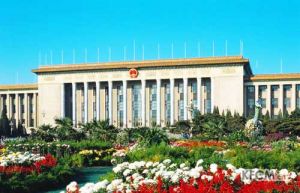Difference between revisions of "Great Hall of the People"
imported>Ciic (Created page with 'thumb|300px|right The '''Great Hall of the People''' lies on the west side of Tian'anmen Square with its main entrance facing the square. Behind the main ent...') |
imported>Ciic |
||
| (6 intermediate revisions by 3 users not shown) | |||
| Line 1: | Line 1: | ||
| − | [[File: | + | [[File:Great Hall of the People (人民大会堂).jpg|thumb|300px|right]] |
| − | + | ||
| + | Located at the western edge of [[Tian’anmen Square]], '''The Great Hall of the People''' ('''人民大会堂''') was designed to house the country’s legislative and political conferences as well as ceremonial events. Completed in [[1959]], it is regarded as one of the 10 Great Constructions, which include [[the National Museum of China]], [[the Beijing Railway Station]] and [[Workers Stadium]], all of which were constructed for the 10th anniversary of the founding of the [[People’s Republic of China]]. Each March, thousands of delegates flock to the hall to attend the annual sessions of [[NPC]] and [[CPPCC]]. In addition, every five years, the Communist Party of China holds its National Congress there. | ||
| − | The | + | The Great Hall of the People consists of central, northern and southern sections. The central section is composed of the Great Auditorium, the main auditorium, the Congress Hall, the central hall and other main halls. The State banquet hall sits at the northern part while the southern part houses the office building of the Standing Committee of the [[National People’s Congress of China]]. The Great Hall of the People also contains halls designated for the provinces, special administrative regions and autonomous regions, such as [[Beijing Hall]], Taiwan Hall and [[Xinjiang Uygur Autonomous Region Hall]]. |
| + | |||
| + | Concerts and other ceremonial events are also held in the hall, and it’s open to the public when political conferences are not in session. | ||
| + | |||
| + | [[Category:Architecture]] | ||
Latest revision as of 12:57, 13 March 2015
Located at the western edge of Tian’anmen Square, The Great Hall of the People (人民大会堂) was designed to house the country’s legislative and political conferences as well as ceremonial events. Completed in 1959, it is regarded as one of the 10 Great Constructions, which include the National Museum of China, the Beijing Railway Station and Workers Stadium, all of which were constructed for the 10th anniversary of the founding of the People’s Republic of China. Each March, thousands of delegates flock to the hall to attend the annual sessions of NPC and CPPCC. In addition, every five years, the Communist Party of China holds its National Congress there.
The Great Hall of the People consists of central, northern and southern sections. The central section is composed of the Great Auditorium, the main auditorium, the Congress Hall, the central hall and other main halls. The State banquet hall sits at the northern part while the southern part houses the office building of the Standing Committee of the National People’s Congress of China. The Great Hall of the People also contains halls designated for the provinces, special administrative regions and autonomous regions, such as Beijing Hall, Taiwan Hall and Xinjiang Uygur Autonomous Region Hall.
Concerts and other ceremonial events are also held in the hall, and it’s open to the public when political conferences are not in session.
